Therapeutic communication.
VerifiedAdded on 2022/07/21
|11
|3949
|34
AI Summary
Contribute Materials
Your contribution can guide someone’s learning journey. Share your
documents today.
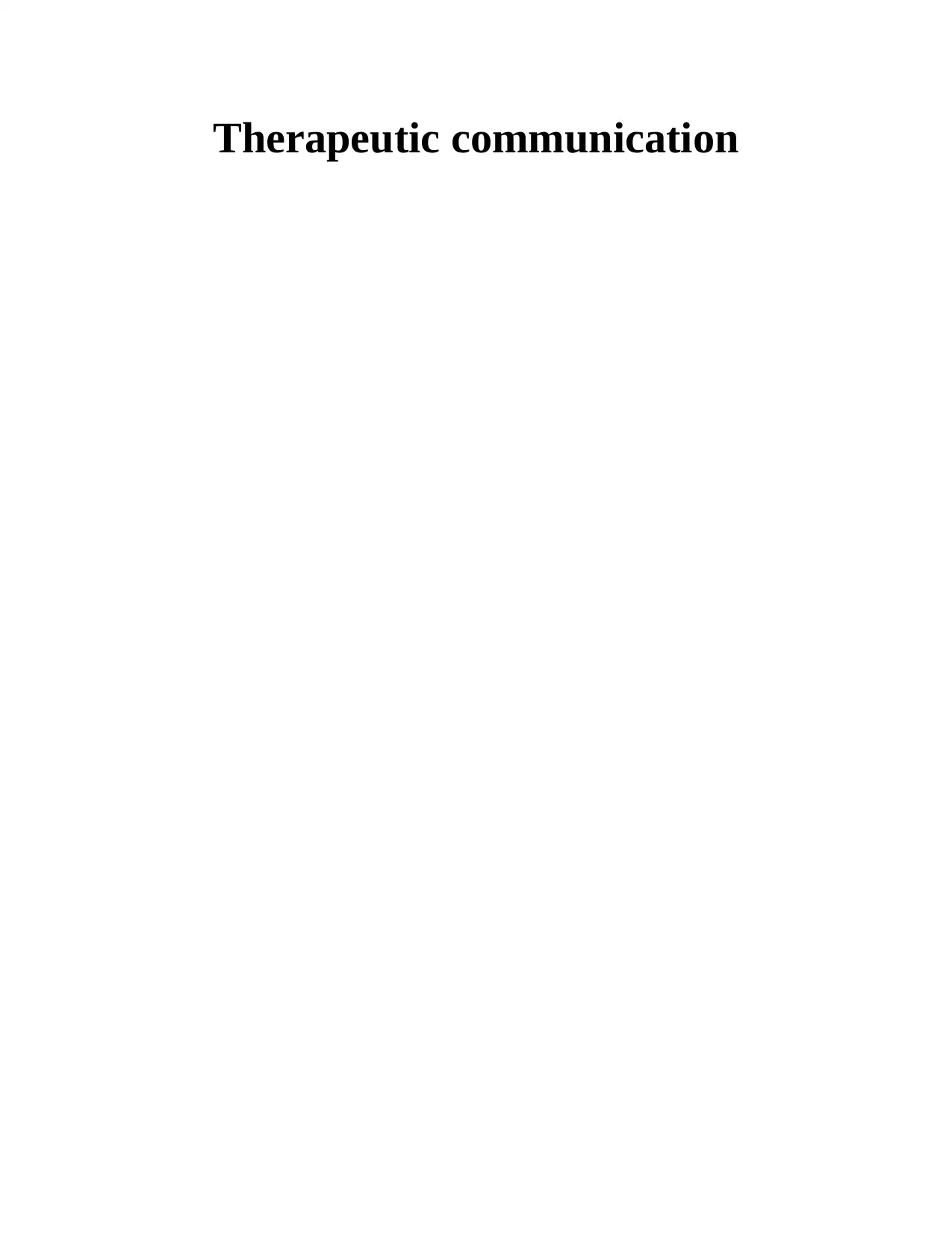
Therapeutic communication
Secure Best Marks with AI Grader
Need help grading? Try our AI Grader for instant feedback on your assignments.
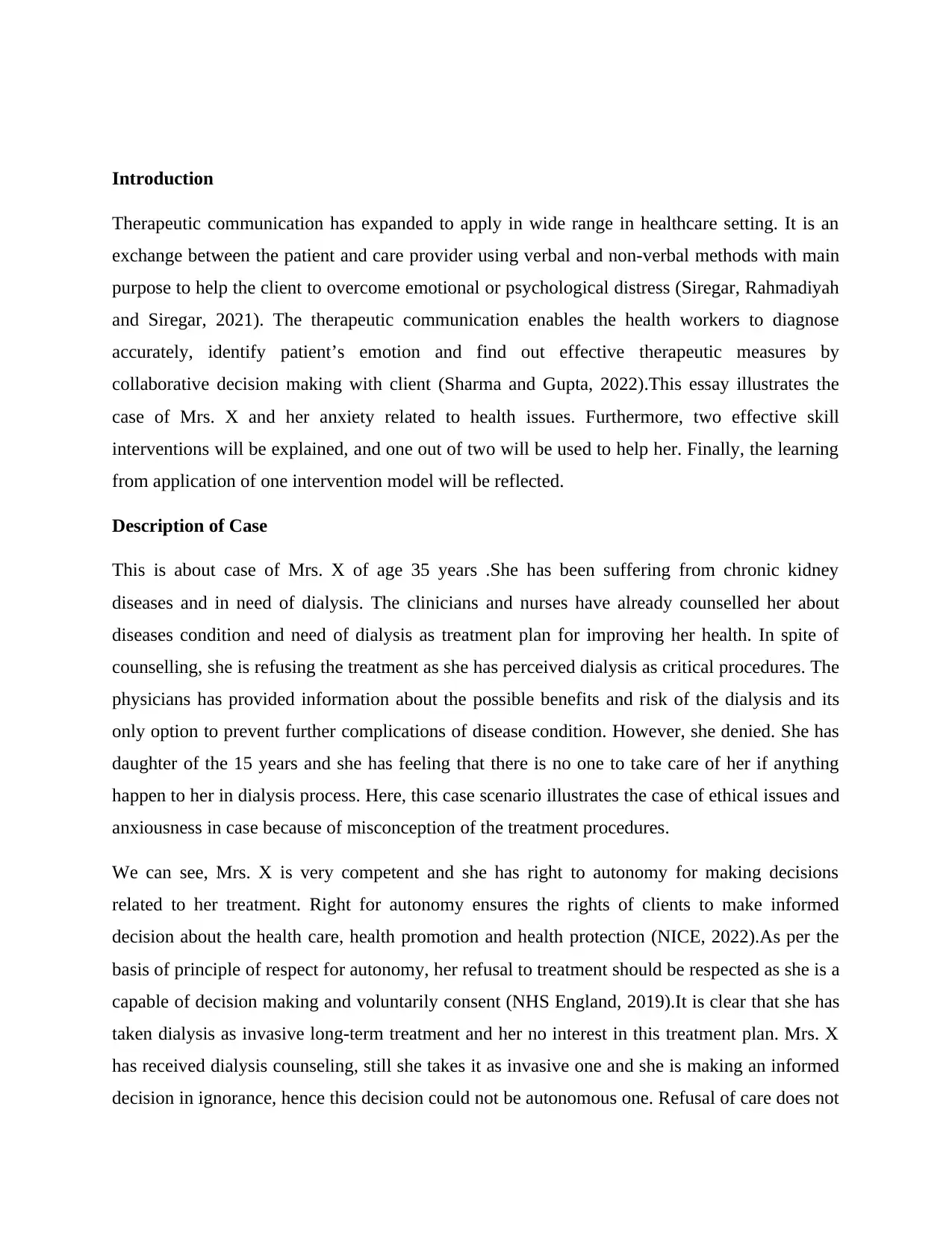
Introduction
Therapeutic communication has expanded to apply in wide range in healthcare setting. It is an
exchange between the patient and care provider using verbal and non-verbal methods with main
purpose to help the client to overcome emotional or psychological distress (Siregar, Rahmadiyah
and Siregar, 2021). The therapeutic communication enables the health workers to diagnose
accurately, identify patient’s emotion and find out effective therapeutic measures by
collaborative decision making with client (Sharma and Gupta, 2022).This essay illustrates the
case of Mrs. X and her anxiety related to health issues. Furthermore, two effective skill
interventions will be explained, and one out of two will be used to help her. Finally, the learning
from application of one intervention model will be reflected.
Description of Case
This is about case of Mrs. X of age 35 years .She has been suffering from chronic kidney
diseases and in need of dialysis. The clinicians and nurses have already counselled her about
diseases condition and need of dialysis as treatment plan for improving her health. In spite of
counselling, she is refusing the treatment as she has perceived dialysis as critical procedures. The
physicians has provided information about the possible benefits and risk of the dialysis and its
only option to prevent further complications of disease condition. However, she denied. She has
daughter of the 15 years and she has feeling that there is no one to take care of her if anything
happen to her in dialysis process. Here, this case scenario illustrates the case of ethical issues and
anxiousness in case because of misconception of the treatment procedures.
We can see, Mrs. X is very competent and she has right to autonomy for making decisions
related to her treatment. Right for autonomy ensures the rights of clients to make informed
decision about the health care, health promotion and health protection (NICE, 2022).As per the
basis of principle of respect for autonomy, her refusal to treatment should be respected as she is a
capable of decision making and voluntarily consent (NHS England, 2019).It is clear that she has
taken dialysis as invasive long-term treatment and her no interest in this treatment plan. Mrs. X
has received dialysis counseling, still she takes it as invasive one and she is making an informed
decision in ignorance, hence this decision could not be autonomous one. Refusal of care does not
Therapeutic communication has expanded to apply in wide range in healthcare setting. It is an
exchange between the patient and care provider using verbal and non-verbal methods with main
purpose to help the client to overcome emotional or psychological distress (Siregar, Rahmadiyah
and Siregar, 2021). The therapeutic communication enables the health workers to diagnose
accurately, identify patient’s emotion and find out effective therapeutic measures by
collaborative decision making with client (Sharma and Gupta, 2022).This essay illustrates the
case of Mrs. X and her anxiety related to health issues. Furthermore, two effective skill
interventions will be explained, and one out of two will be used to help her. Finally, the learning
from application of one intervention model will be reflected.
Description of Case
This is about case of Mrs. X of age 35 years .She has been suffering from chronic kidney
diseases and in need of dialysis. The clinicians and nurses have already counselled her about
diseases condition and need of dialysis as treatment plan for improving her health. In spite of
counselling, she is refusing the treatment as she has perceived dialysis as critical procedures. The
physicians has provided information about the possible benefits and risk of the dialysis and its
only option to prevent further complications of disease condition. However, she denied. She has
daughter of the 15 years and she has feeling that there is no one to take care of her if anything
happen to her in dialysis process. Here, this case scenario illustrates the case of ethical issues and
anxiousness in case because of misconception of the treatment procedures.
We can see, Mrs. X is very competent and she has right to autonomy for making decisions
related to her treatment. Right for autonomy ensures the rights of clients to make informed
decision about the health care, health promotion and health protection (NICE, 2022).As per the
basis of principle of respect for autonomy, her refusal to treatment should be respected as she is a
capable of decision making and voluntarily consent (NHS England, 2019).It is clear that she has
taken dialysis as invasive long-term treatment and her no interest in this treatment plan. Mrs. X
has received dialysis counseling, still she takes it as invasive one and she is making an informed
decision in ignorance, hence this decision could not be autonomous one. Refusal of care does not
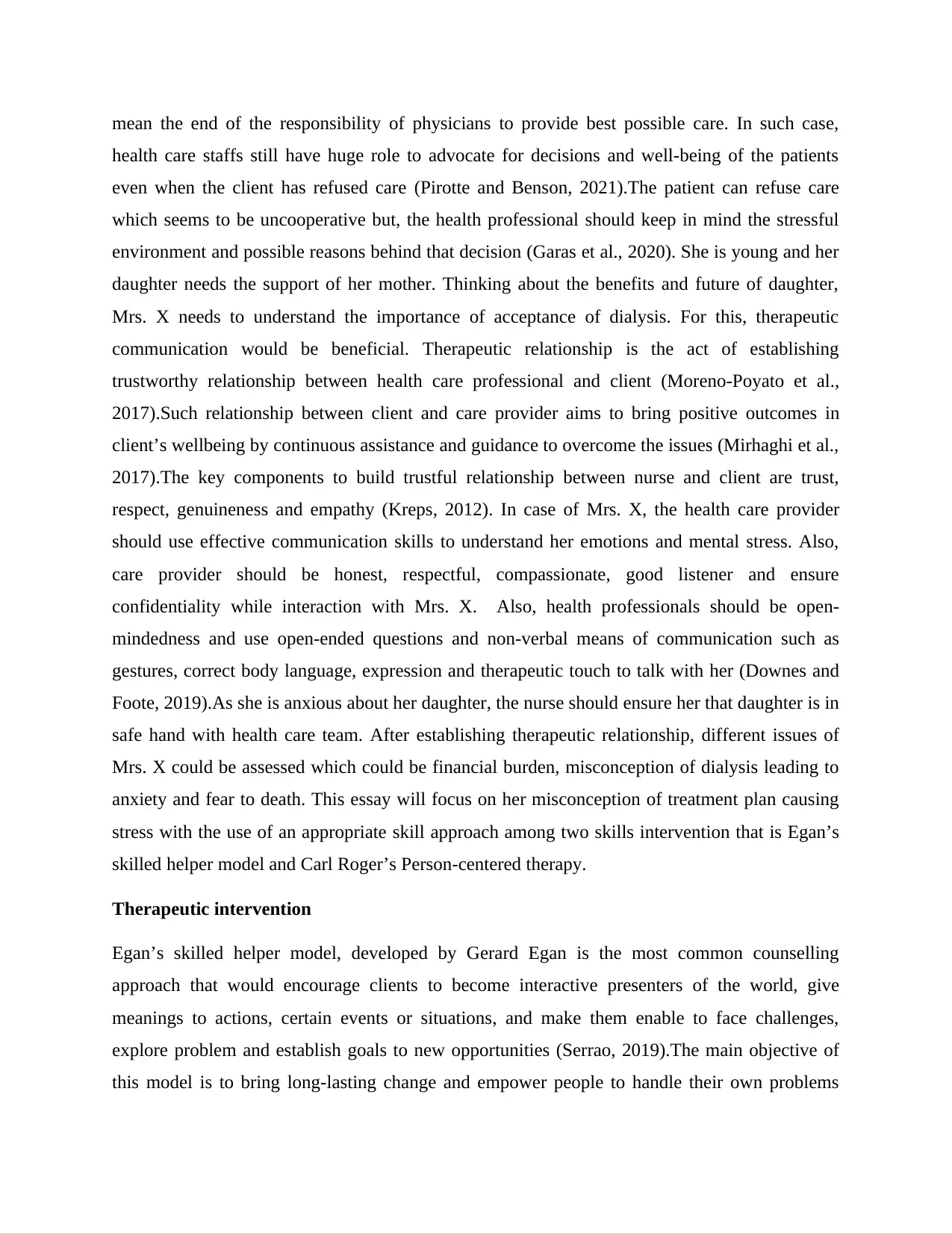
mean the end of the responsibility of physicians to provide best possible care. In such case,
health care staffs still have huge role to advocate for decisions and well-being of the patients
even when the client has refused care (Pirotte and Benson, 2021).The patient can refuse care
which seems to be uncooperative but, the health professional should keep in mind the stressful
environment and possible reasons behind that decision (Garas et al., 2020). She is young and her
daughter needs the support of her mother. Thinking about the benefits and future of daughter,
Mrs. X needs to understand the importance of acceptance of dialysis. For this, therapeutic
communication would be beneficial. Therapeutic relationship is the act of establishing
trustworthy relationship between health care professional and client (Moreno-Poyato et al.,
2017).Such relationship between client and care provider aims to bring positive outcomes in
client’s wellbeing by continuous assistance and guidance to overcome the issues (Mirhaghi et al.,
2017).The key components to build trustful relationship between nurse and client are trust,
respect, genuineness and empathy (Kreps, 2012). In case of Mrs. X, the health care provider
should use effective communication skills to understand her emotions and mental stress. Also,
care provider should be honest, respectful, compassionate, good listener and ensure
confidentiality while interaction with Mrs. X. Also, health professionals should be open-
mindedness and use open-ended questions and non-verbal means of communication such as
gestures, correct body language, expression and therapeutic touch to talk with her (Downes and
Foote, 2019).As she is anxious about her daughter, the nurse should ensure her that daughter is in
safe hand with health care team. After establishing therapeutic relationship, different issues of
Mrs. X could be assessed which could be financial burden, misconception of dialysis leading to
anxiety and fear to death. This essay will focus on her misconception of treatment plan causing
stress with the use of an appropriate skill approach among two skills intervention that is Egan’s
skilled helper model and Carl Roger’s Person-centered therapy.
Therapeutic intervention
Egan’s skilled helper model, developed by Gerard Egan is the most common counselling
approach that would encourage clients to become interactive presenters of the world, give
meanings to actions, certain events or situations, and make them enable to face challenges,
explore problem and establish goals to new opportunities (Serrao, 2019).The main objective of
this model is to bring long-lasting change and empower people to handle their own problems
health care staffs still have huge role to advocate for decisions and well-being of the patients
even when the client has refused care (Pirotte and Benson, 2021).The patient can refuse care
which seems to be uncooperative but, the health professional should keep in mind the stressful
environment and possible reasons behind that decision (Garas et al., 2020). She is young and her
daughter needs the support of her mother. Thinking about the benefits and future of daughter,
Mrs. X needs to understand the importance of acceptance of dialysis. For this, therapeutic
communication would be beneficial. Therapeutic relationship is the act of establishing
trustworthy relationship between health care professional and client (Moreno-Poyato et al.,
2017).Such relationship between client and care provider aims to bring positive outcomes in
client’s wellbeing by continuous assistance and guidance to overcome the issues (Mirhaghi et al.,
2017).The key components to build trustful relationship between nurse and client are trust,
respect, genuineness and empathy (Kreps, 2012). In case of Mrs. X, the health care provider
should use effective communication skills to understand her emotions and mental stress. Also,
care provider should be honest, respectful, compassionate, good listener and ensure
confidentiality while interaction with Mrs. X. Also, health professionals should be open-
mindedness and use open-ended questions and non-verbal means of communication such as
gestures, correct body language, expression and therapeutic touch to talk with her (Downes and
Foote, 2019).As she is anxious about her daughter, the nurse should ensure her that daughter is in
safe hand with health care team. After establishing therapeutic relationship, different issues of
Mrs. X could be assessed which could be financial burden, misconception of dialysis leading to
anxiety and fear to death. This essay will focus on her misconception of treatment plan causing
stress with the use of an appropriate skill approach among two skills intervention that is Egan’s
skilled helper model and Carl Roger’s Person-centered therapy.
Therapeutic intervention
Egan’s skilled helper model, developed by Gerard Egan is the most common counselling
approach that would encourage clients to become interactive presenters of the world, give
meanings to actions, certain events or situations, and make them enable to face challenges,
explore problem and establish goals to new opportunities (Serrao, 2019).The main objective of
this model is to bring long-lasting change and empower people to handle their own problems
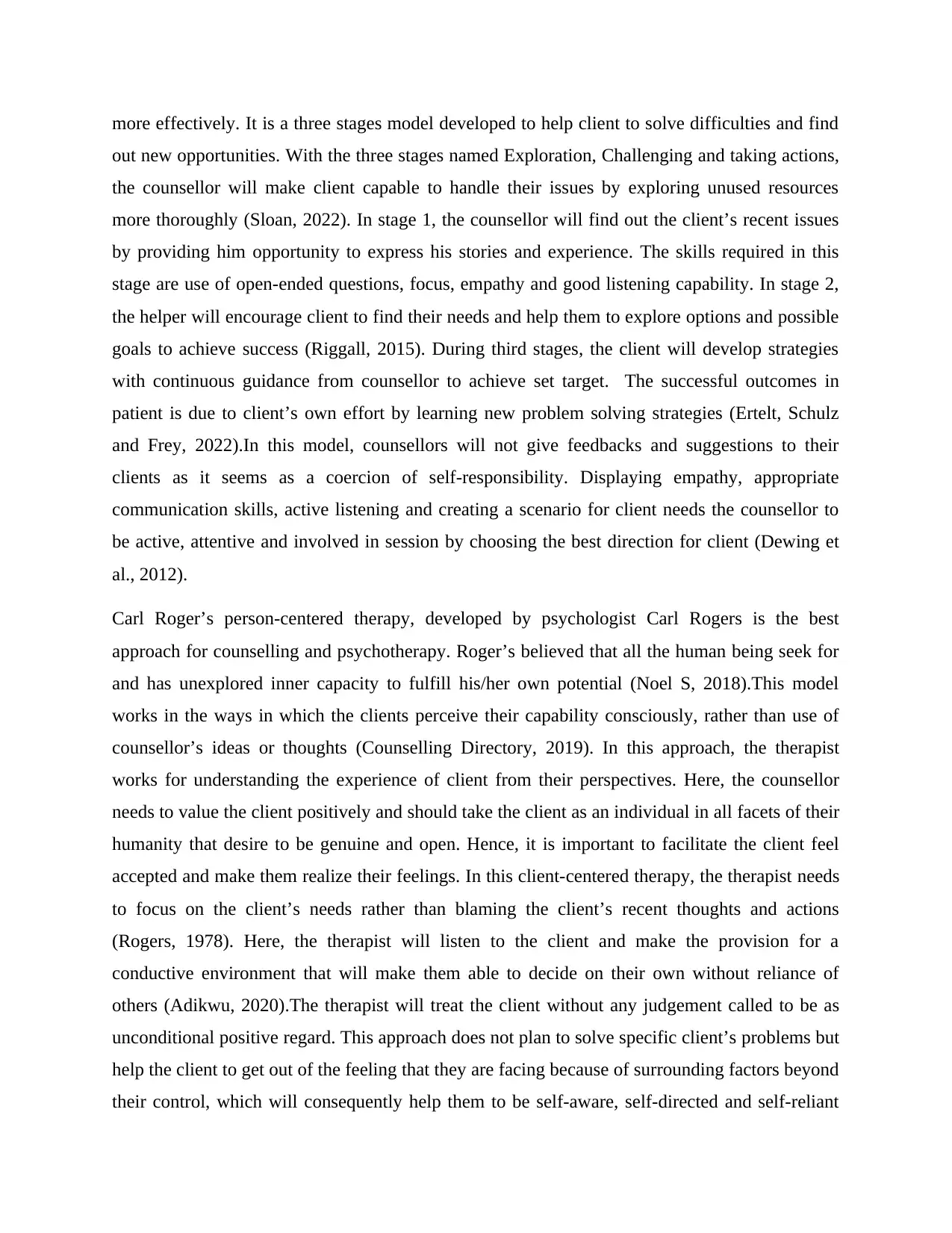
more effectively. It is a three stages model developed to help client to solve difficulties and find
out new opportunities. With the three stages named Exploration, Challenging and taking actions,
the counsellor will make client capable to handle their issues by exploring unused resources
more thoroughly (Sloan, 2022). In stage 1, the counsellor will find out the client’s recent issues
by providing him opportunity to express his stories and experience. The skills required in this
stage are use of open-ended questions, focus, empathy and good listening capability. In stage 2,
the helper will encourage client to find their needs and help them to explore options and possible
goals to achieve success (Riggall, 2015). During third stages, the client will develop strategies
with continuous guidance from counsellor to achieve set target. The successful outcomes in
patient is due to client’s own effort by learning new problem solving strategies (Ertelt, Schulz
and Frey, 2022).In this model, counsellors will not give feedbacks and suggestions to their
clients as it seems as a coercion of self-responsibility. Displaying empathy, appropriate
communication skills, active listening and creating a scenario for client needs the counsellor to
be active, attentive and involved in session by choosing the best direction for client (Dewing et
al., 2012).
Carl Roger’s person-centered therapy, developed by psychologist Carl Rogers is the best
approach for counselling and psychotherapy. Roger’s believed that all the human being seek for
and has unexplored inner capacity to fulfill his/her own potential (Noel S, 2018).This model
works in the ways in which the clients perceive their capability consciously, rather than use of
counsellor’s ideas or thoughts (Counselling Directory, 2019). In this approach, the therapist
works for understanding the experience of client from their perspectives. Here, the counsellor
needs to value the client positively and should take the client as an individual in all facets of their
humanity that desire to be genuine and open. Hence, it is important to facilitate the client feel
accepted and make them realize their feelings. In this client-centered therapy, the therapist needs
to focus on the client’s needs rather than blaming the client’s recent thoughts and actions
(Rogers, 1978). Here, the therapist will listen to the client and make the provision for a
conductive environment that will make them able to decide on their own without reliance of
others (Adikwu, 2020).The therapist will treat the client without any judgement called to be as
unconditional positive regard. This approach does not plan to solve specific client’s problems but
help the client to get out of the feeling that they are facing because of surrounding factors beyond
their control, which will consequently help them to be self-aware, self-directed and self-reliant
out new opportunities. With the three stages named Exploration, Challenging and taking actions,
the counsellor will make client capable to handle their issues by exploring unused resources
more thoroughly (Sloan, 2022). In stage 1, the counsellor will find out the client’s recent issues
by providing him opportunity to express his stories and experience. The skills required in this
stage are use of open-ended questions, focus, empathy and good listening capability. In stage 2,
the helper will encourage client to find their needs and help them to explore options and possible
goals to achieve success (Riggall, 2015). During third stages, the client will develop strategies
with continuous guidance from counsellor to achieve set target. The successful outcomes in
patient is due to client’s own effort by learning new problem solving strategies (Ertelt, Schulz
and Frey, 2022).In this model, counsellors will not give feedbacks and suggestions to their
clients as it seems as a coercion of self-responsibility. Displaying empathy, appropriate
communication skills, active listening and creating a scenario for client needs the counsellor to
be active, attentive and involved in session by choosing the best direction for client (Dewing et
al., 2012).
Carl Roger’s person-centered therapy, developed by psychologist Carl Rogers is the best
approach for counselling and psychotherapy. Roger’s believed that all the human being seek for
and has unexplored inner capacity to fulfill his/her own potential (Noel S, 2018).This model
works in the ways in which the clients perceive their capability consciously, rather than use of
counsellor’s ideas or thoughts (Counselling Directory, 2019). In this approach, the therapist
works for understanding the experience of client from their perspectives. Here, the counsellor
needs to value the client positively and should take the client as an individual in all facets of their
humanity that desire to be genuine and open. Hence, it is important to facilitate the client feel
accepted and make them realize their feelings. In this client-centered therapy, the therapist needs
to focus on the client’s needs rather than blaming the client’s recent thoughts and actions
(Rogers, 1978). Here, the therapist will listen to the client and make the provision for a
conductive environment that will make them able to decide on their own without reliance of
others (Adikwu, 2020).The therapist will treat the client without any judgement called to be as
unconditional positive regard. This approach does not plan to solve specific client’s problems but
help the client to get out of the feeling that they are facing because of surrounding factors beyond
their control, which will consequently help them to be self-aware, self-directed and self-reliant
Secure Best Marks with AI Grader
Need help grading? Try our AI Grader for instant feedback on your assignments.
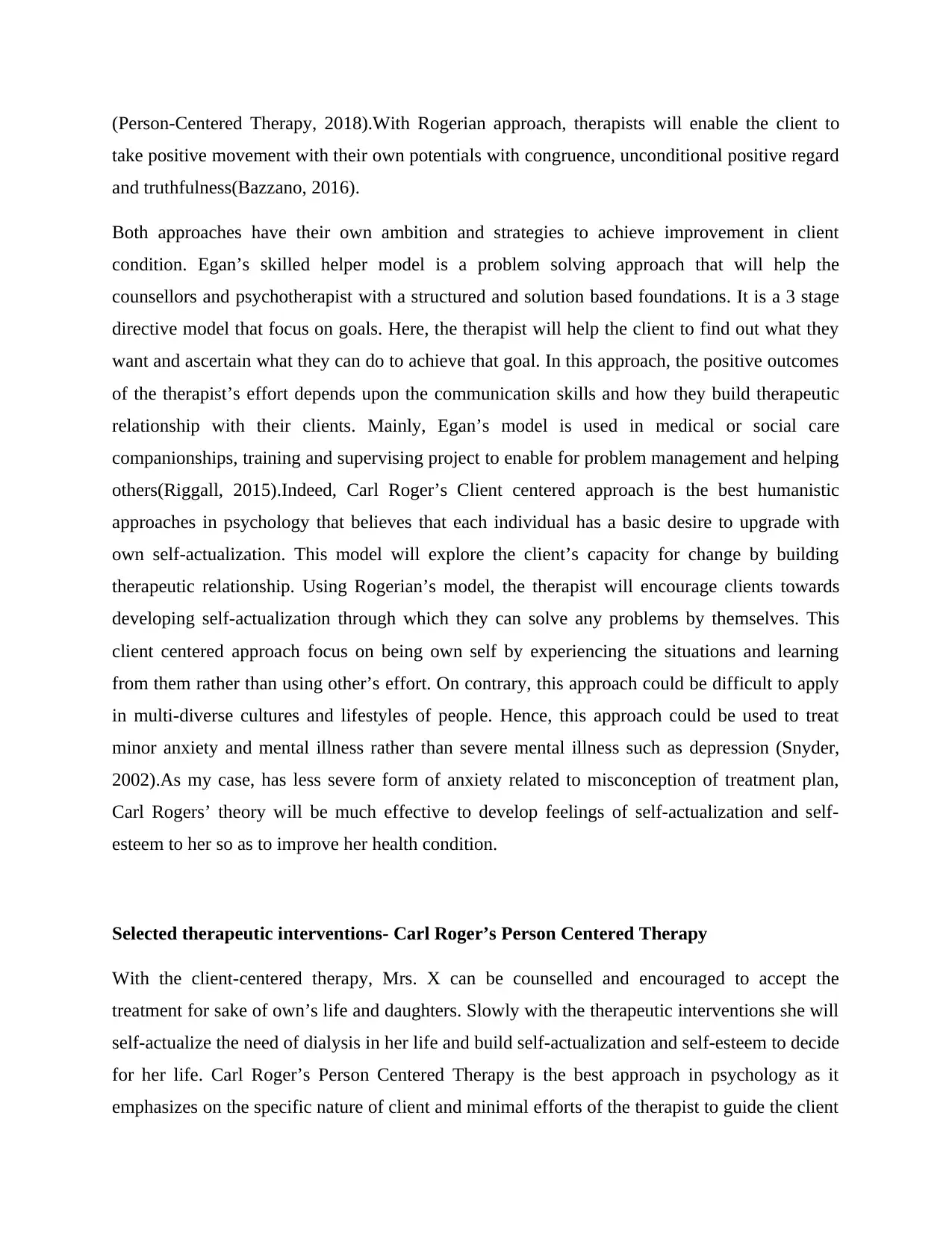
(Person-Centered Therapy, 2018).With Rogerian approach, therapists will enable the client to
take positive movement with their own potentials with congruence, unconditional positive regard
and truthfulness(Bazzano, 2016).
Both approaches have their own ambition and strategies to achieve improvement in client
condition. Egan’s skilled helper model is a problem solving approach that will help the
counsellors and psychotherapist with a structured and solution based foundations. It is a 3 stage
directive model that focus on goals. Here, the therapist will help the client to find out what they
want and ascertain what they can do to achieve that goal. In this approach, the positive outcomes
of the therapist’s effort depends upon the communication skills and how they build therapeutic
relationship with their clients. Mainly, Egan’s model is used in medical or social care
companionships, training and supervising project to enable for problem management and helping
others(Riggall, 2015).Indeed, Carl Roger’s Client centered approach is the best humanistic
approaches in psychology that believes that each individual has a basic desire to upgrade with
own self-actualization. This model will explore the client’s capacity for change by building
therapeutic relationship. Using Rogerian’s model, the therapist will encourage clients towards
developing self-actualization through which they can solve any problems by themselves. This
client centered approach focus on being own self by experiencing the situations and learning
from them rather than using other’s effort. On contrary, this approach could be difficult to apply
in multi-diverse cultures and lifestyles of people. Hence, this approach could be used to treat
minor anxiety and mental illness rather than severe mental illness such as depression (Snyder,
2002).As my case, has less severe form of anxiety related to misconception of treatment plan,
Carl Rogers’ theory will be much effective to develop feelings of self-actualization and self-
esteem to her so as to improve her health condition.
Selected therapeutic interventions- Carl Roger’s Person Centered Therapy
With the client-centered therapy, Mrs. X can be counselled and encouraged to accept the
treatment for sake of own’s life and daughters. Slowly with the therapeutic interventions she will
self-actualize the need of dialysis in her life and build self-actualization and self-esteem to decide
for her life. Carl Roger’s Person Centered Therapy is the best approach in psychology as it
emphasizes on the specific nature of client and minimal efforts of the therapist to guide the client
take positive movement with their own potentials with congruence, unconditional positive regard
and truthfulness(Bazzano, 2016).
Both approaches have their own ambition and strategies to achieve improvement in client
condition. Egan’s skilled helper model is a problem solving approach that will help the
counsellors and psychotherapist with a structured and solution based foundations. It is a 3 stage
directive model that focus on goals. Here, the therapist will help the client to find out what they
want and ascertain what they can do to achieve that goal. In this approach, the positive outcomes
of the therapist’s effort depends upon the communication skills and how they build therapeutic
relationship with their clients. Mainly, Egan’s model is used in medical or social care
companionships, training and supervising project to enable for problem management and helping
others(Riggall, 2015).Indeed, Carl Roger’s Client centered approach is the best humanistic
approaches in psychology that believes that each individual has a basic desire to upgrade with
own self-actualization. This model will explore the client’s capacity for change by building
therapeutic relationship. Using Rogerian’s model, the therapist will encourage clients towards
developing self-actualization through which they can solve any problems by themselves. This
client centered approach focus on being own self by experiencing the situations and learning
from them rather than using other’s effort. On contrary, this approach could be difficult to apply
in multi-diverse cultures and lifestyles of people. Hence, this approach could be used to treat
minor anxiety and mental illness rather than severe mental illness such as depression (Snyder,
2002).As my case, has less severe form of anxiety related to misconception of treatment plan,
Carl Rogers’ theory will be much effective to develop feelings of self-actualization and self-
esteem to her so as to improve her health condition.
Selected therapeutic interventions- Carl Roger’s Person Centered Therapy
With the client-centered therapy, Mrs. X can be counselled and encouraged to accept the
treatment for sake of own’s life and daughters. Slowly with the therapeutic interventions she will
self-actualize the need of dialysis in her life and build self-actualization and self-esteem to decide
for her life. Carl Roger’s Person Centered Therapy is the best approach in psychology as it
emphasizes on the specific nature of client and minimal efforts of the therapist to guide the client
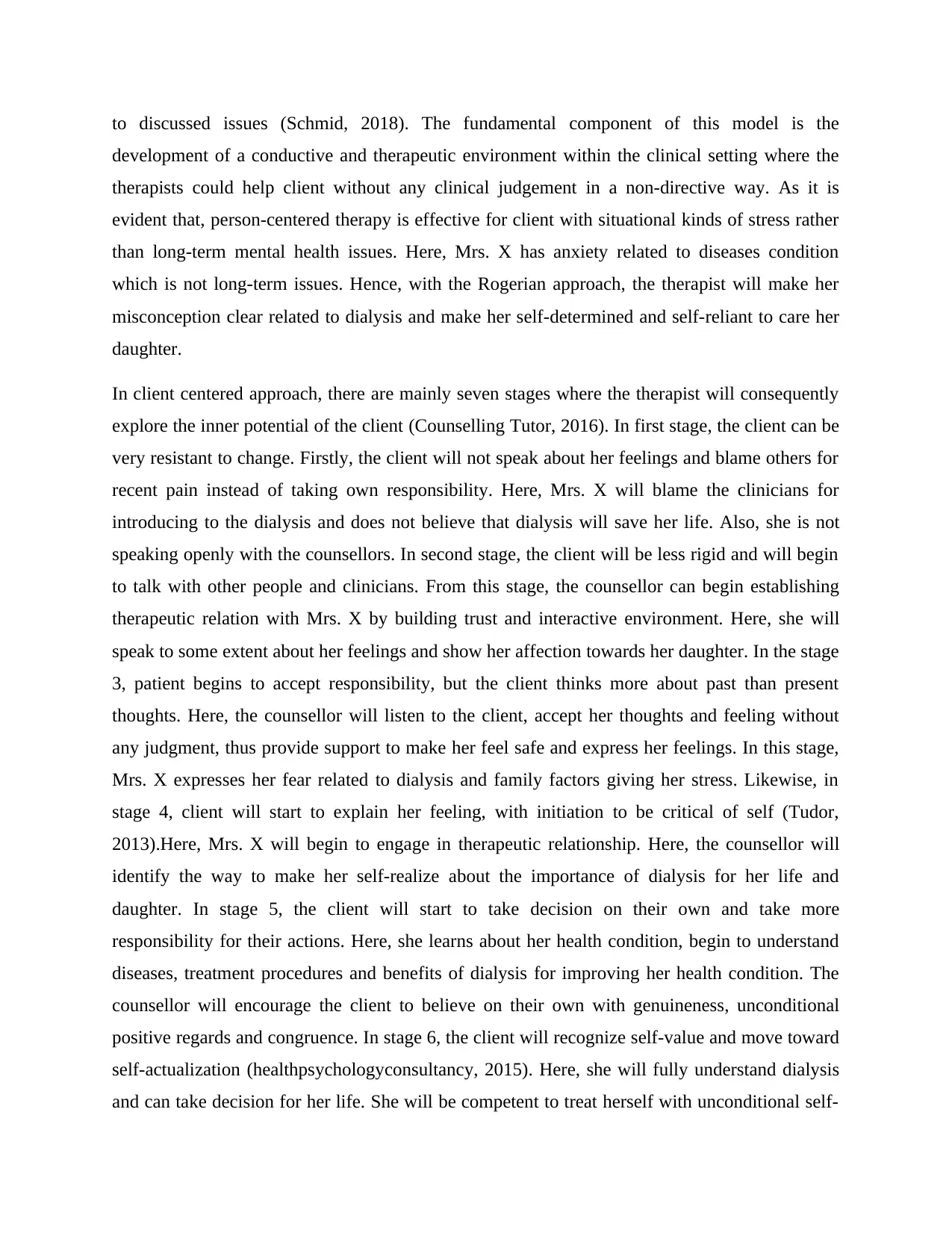
to discussed issues (Schmid, 2018). The fundamental component of this model is the
development of a conductive and therapeutic environment within the clinical setting where the
therapists could help client without any clinical judgement in a non-directive way. As it is
evident that, person-centered therapy is effective for client with situational kinds of stress rather
than long-term mental health issues. Here, Mrs. X has anxiety related to diseases condition
which is not long-term issues. Hence, with the Rogerian approach, the therapist will make her
misconception clear related to dialysis and make her self-determined and self-reliant to care her
daughter.
In client centered approach, there are mainly seven stages where the therapist will consequently
explore the inner potential of the client (Counselling Tutor, 2016). In first stage, the client can be
very resistant to change. Firstly, the client will not speak about her feelings and blame others for
recent pain instead of taking own responsibility. Here, Mrs. X will blame the clinicians for
introducing to the dialysis and does not believe that dialysis will save her life. Also, she is not
speaking openly with the counsellors. In second stage, the client will be less rigid and will begin
to talk with other people and clinicians. From this stage, the counsellor can begin establishing
therapeutic relation with Mrs. X by building trust and interactive environment. Here, she will
speak to some extent about her feelings and show her affection towards her daughter. In the stage
3, patient begins to accept responsibility, but the client thinks more about past than present
thoughts. Here, the counsellor will listen to the client, accept her thoughts and feeling without
any judgment, thus provide support to make her feel safe and express her feelings. In this stage,
Mrs. X expresses her fear related to dialysis and family factors giving her stress. Likewise, in
stage 4, client will start to explain her feeling, with initiation to be critical of self (Tudor,
2013).Here, Mrs. X will begin to engage in therapeutic relationship. Here, the counsellor will
identify the way to make her self-realize about the importance of dialysis for her life and
daughter. In stage 5, the client will start to take decision on their own and take more
responsibility for their actions. Here, she learns about her health condition, begin to understand
diseases, treatment procedures and benefits of dialysis for improving her health condition. The
counsellor will encourage the client to believe on their own with genuineness, unconditional
positive regards and congruence. In stage 6, the client will recognize self-value and move toward
self-actualization (healthpsychologyconsultancy, 2015). Here, she will fully understand dialysis
and can take decision for her life. She will be competent to treat herself with unconditional self-
development of a conductive and therapeutic environment within the clinical setting where the
therapists could help client without any clinical judgement in a non-directive way. As it is
evident that, person-centered therapy is effective for client with situational kinds of stress rather
than long-term mental health issues. Here, Mrs. X has anxiety related to diseases condition
which is not long-term issues. Hence, with the Rogerian approach, the therapist will make her
misconception clear related to dialysis and make her self-determined and self-reliant to care her
daughter.
In client centered approach, there are mainly seven stages where the therapist will consequently
explore the inner potential of the client (Counselling Tutor, 2016). In first stage, the client can be
very resistant to change. Firstly, the client will not speak about her feelings and blame others for
recent pain instead of taking own responsibility. Here, Mrs. X will blame the clinicians for
introducing to the dialysis and does not believe that dialysis will save her life. Also, she is not
speaking openly with the counsellors. In second stage, the client will be less rigid and will begin
to talk with other people and clinicians. From this stage, the counsellor can begin establishing
therapeutic relation with Mrs. X by building trust and interactive environment. Here, she will
speak to some extent about her feelings and show her affection towards her daughter. In the stage
3, patient begins to accept responsibility, but the client thinks more about past than present
thoughts. Here, the counsellor will listen to the client, accept her thoughts and feeling without
any judgment, thus provide support to make her feel safe and express her feelings. In this stage,
Mrs. X expresses her fear related to dialysis and family factors giving her stress. Likewise, in
stage 4, client will start to explain her feeling, with initiation to be critical of self (Tudor,
2013).Here, Mrs. X will begin to engage in therapeutic relationship. Here, the counsellor will
identify the way to make her self-realize about the importance of dialysis for her life and
daughter. In stage 5, the client will start to take decision on their own and take more
responsibility for their actions. Here, she learns about her health condition, begin to understand
diseases, treatment procedures and benefits of dialysis for improving her health condition. The
counsellor will encourage the client to believe on their own with genuineness, unconditional
positive regards and congruence. In stage 6, the client will recognize self-value and move toward
self-actualization (healthpsychologyconsultancy, 2015). Here, she will fully understand dialysis
and can take decision for her life. She will be competent to treat herself with unconditional self-
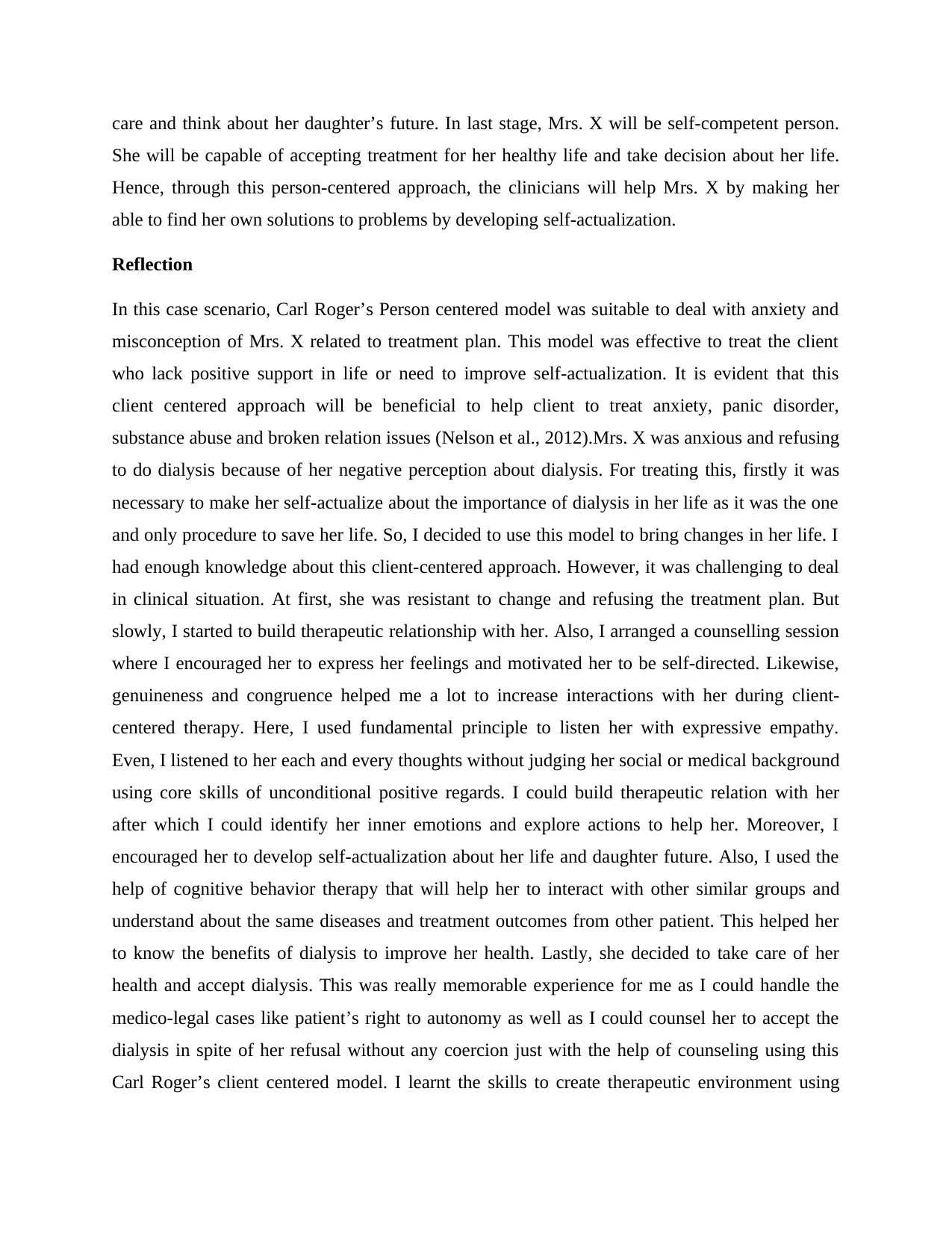
care and think about her daughter’s future. In last stage, Mrs. X will be self-competent person.
She will be capable of accepting treatment for her healthy life and take decision about her life.
Hence, through this person-centered approach, the clinicians will help Mrs. X by making her
able to find her own solutions to problems by developing self-actualization.
Reflection
In this case scenario, Carl Roger’s Person centered model was suitable to deal with anxiety and
misconception of Mrs. X related to treatment plan. This model was effective to treat the client
who lack positive support in life or need to improve self-actualization. It is evident that this
client centered approach will be beneficial to help client to treat anxiety, panic disorder,
substance abuse and broken relation issues (Nelson et al., 2012).Mrs. X was anxious and refusing
to do dialysis because of her negative perception about dialysis. For treating this, firstly it was
necessary to make her self-actualize about the importance of dialysis in her life as it was the one
and only procedure to save her life. So, I decided to use this model to bring changes in her life. I
had enough knowledge about this client-centered approach. However, it was challenging to deal
in clinical situation. At first, she was resistant to change and refusing the treatment plan. But
slowly, I started to build therapeutic relationship with her. Also, I arranged a counselling session
where I encouraged her to express her feelings and motivated her to be self-directed. Likewise,
genuineness and congruence helped me a lot to increase interactions with her during client-
centered therapy. Here, I used fundamental principle to listen her with expressive empathy.
Even, I listened to her each and every thoughts without judging her social or medical background
using core skills of unconditional positive regards. I could build therapeutic relation with her
after which I could identify her inner emotions and explore actions to help her. Moreover, I
encouraged her to develop self-actualization about her life and daughter future. Also, I used the
help of cognitive behavior therapy that will help her to interact with other similar groups and
understand about the same diseases and treatment outcomes from other patient. This helped her
to know the benefits of dialysis to improve her health. Lastly, she decided to take care of her
health and accept dialysis. This was really memorable experience for me as I could handle the
medico-legal cases like patient’s right to autonomy as well as I could counsel her to accept the
dialysis in spite of her refusal without any coercion just with the help of counseling using this
Carl Roger’s client centered model. I learnt the skills to create therapeutic environment using
She will be capable of accepting treatment for her healthy life and take decision about her life.
Hence, through this person-centered approach, the clinicians will help Mrs. X by making her
able to find her own solutions to problems by developing self-actualization.
Reflection
In this case scenario, Carl Roger’s Person centered model was suitable to deal with anxiety and
misconception of Mrs. X related to treatment plan. This model was effective to treat the client
who lack positive support in life or need to improve self-actualization. It is evident that this
client centered approach will be beneficial to help client to treat anxiety, panic disorder,
substance abuse and broken relation issues (Nelson et al., 2012).Mrs. X was anxious and refusing
to do dialysis because of her negative perception about dialysis. For treating this, firstly it was
necessary to make her self-actualize about the importance of dialysis in her life as it was the one
and only procedure to save her life. So, I decided to use this model to bring changes in her life. I
had enough knowledge about this client-centered approach. However, it was challenging to deal
in clinical situation. At first, she was resistant to change and refusing the treatment plan. But
slowly, I started to build therapeutic relationship with her. Also, I arranged a counselling session
where I encouraged her to express her feelings and motivated her to be self-directed. Likewise,
genuineness and congruence helped me a lot to increase interactions with her during client-
centered therapy. Here, I used fundamental principle to listen her with expressive empathy.
Even, I listened to her each and every thoughts without judging her social or medical background
using core skills of unconditional positive regards. I could build therapeutic relation with her
after which I could identify her inner emotions and explore actions to help her. Moreover, I
encouraged her to develop self-actualization about her life and daughter future. Also, I used the
help of cognitive behavior therapy that will help her to interact with other similar groups and
understand about the same diseases and treatment outcomes from other patient. This helped her
to know the benefits of dialysis to improve her health. Lastly, she decided to take care of her
health and accept dialysis. This was really memorable experience for me as I could handle the
medico-legal cases like patient’s right to autonomy as well as I could counsel her to accept the
dialysis in spite of her refusal without any coercion just with the help of counseling using this
Carl Roger’s client centered model. I learnt the skills to create therapeutic environment using
Paraphrase This Document
Need a fresh take? Get an instant paraphrase of this document with our AI Paraphraser
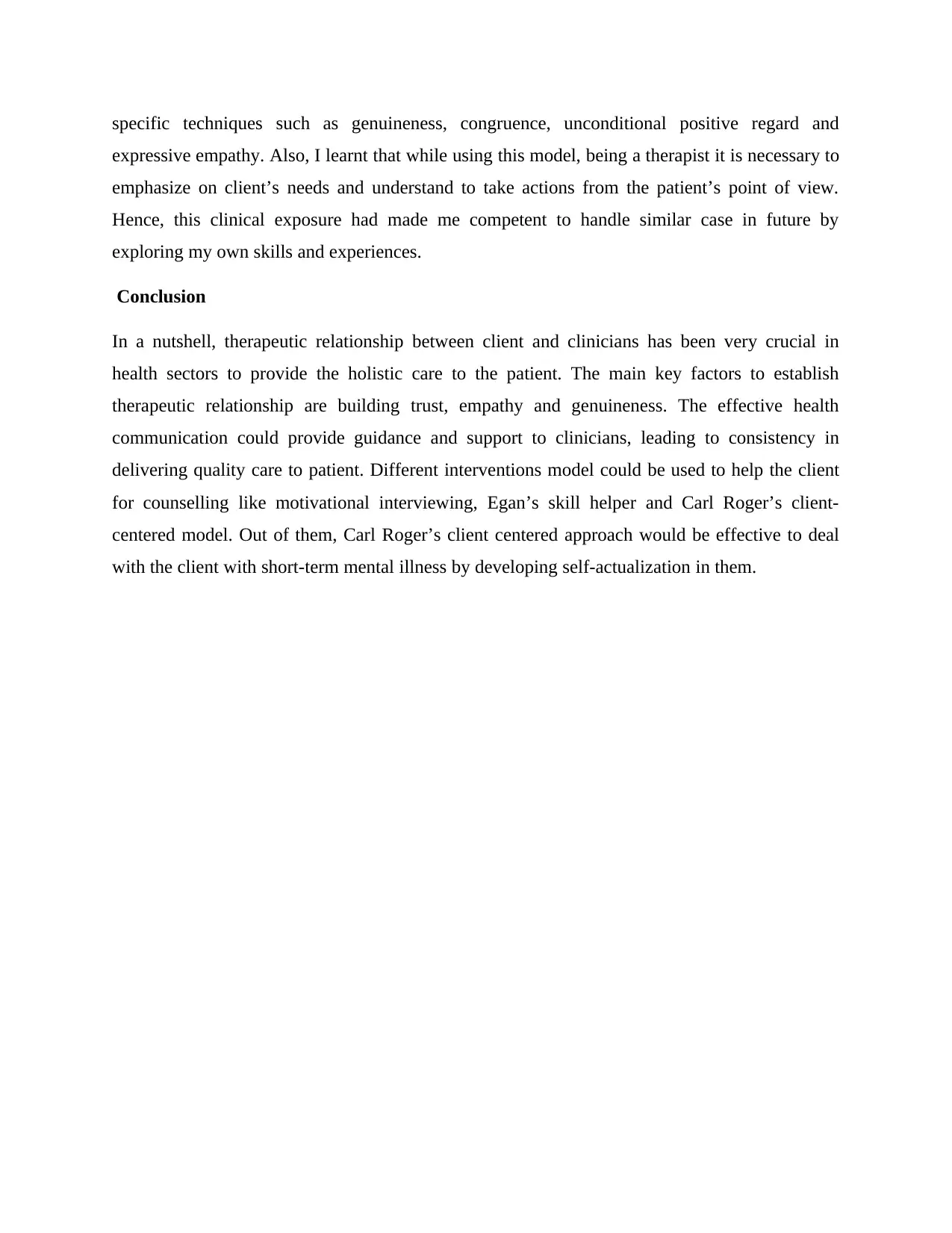
specific techniques such as genuineness, congruence, unconditional positive regard and
expressive empathy. Also, I learnt that while using this model, being a therapist it is necessary to
emphasize on client’s needs and understand to take actions from the patient’s point of view.
Hence, this clinical exposure had made me competent to handle similar case in future by
exploring my own skills and experiences.
Conclusion
In a nutshell, therapeutic relationship between client and clinicians has been very crucial in
health sectors to provide the holistic care to the patient. The main key factors to establish
therapeutic relationship are building trust, empathy and genuineness. The effective health
communication could provide guidance and support to clinicians, leading to consistency in
delivering quality care to patient. Different interventions model could be used to help the client
for counselling like motivational interviewing, Egan’s skill helper and Carl Roger’s client-
centered model. Out of them, Carl Roger’s client centered approach would be effective to deal
with the client with short-term mental illness by developing self-actualization in them.
expressive empathy. Also, I learnt that while using this model, being a therapist it is necessary to
emphasize on client’s needs and understand to take actions from the patient’s point of view.
Hence, this clinical exposure had made me competent to handle similar case in future by
exploring my own skills and experiences.
Conclusion
In a nutshell, therapeutic relationship between client and clinicians has been very crucial in
health sectors to provide the holistic care to the patient. The main key factors to establish
therapeutic relationship are building trust, empathy and genuineness. The effective health
communication could provide guidance and support to clinicians, leading to consistency in
delivering quality care to patient. Different interventions model could be used to help the client
for counselling like motivational interviewing, Egan’s skill helper and Carl Roger’s client-
centered model. Out of them, Carl Roger’s client centered approach would be effective to deal
with the client with short-term mental illness by developing self-actualization in them.
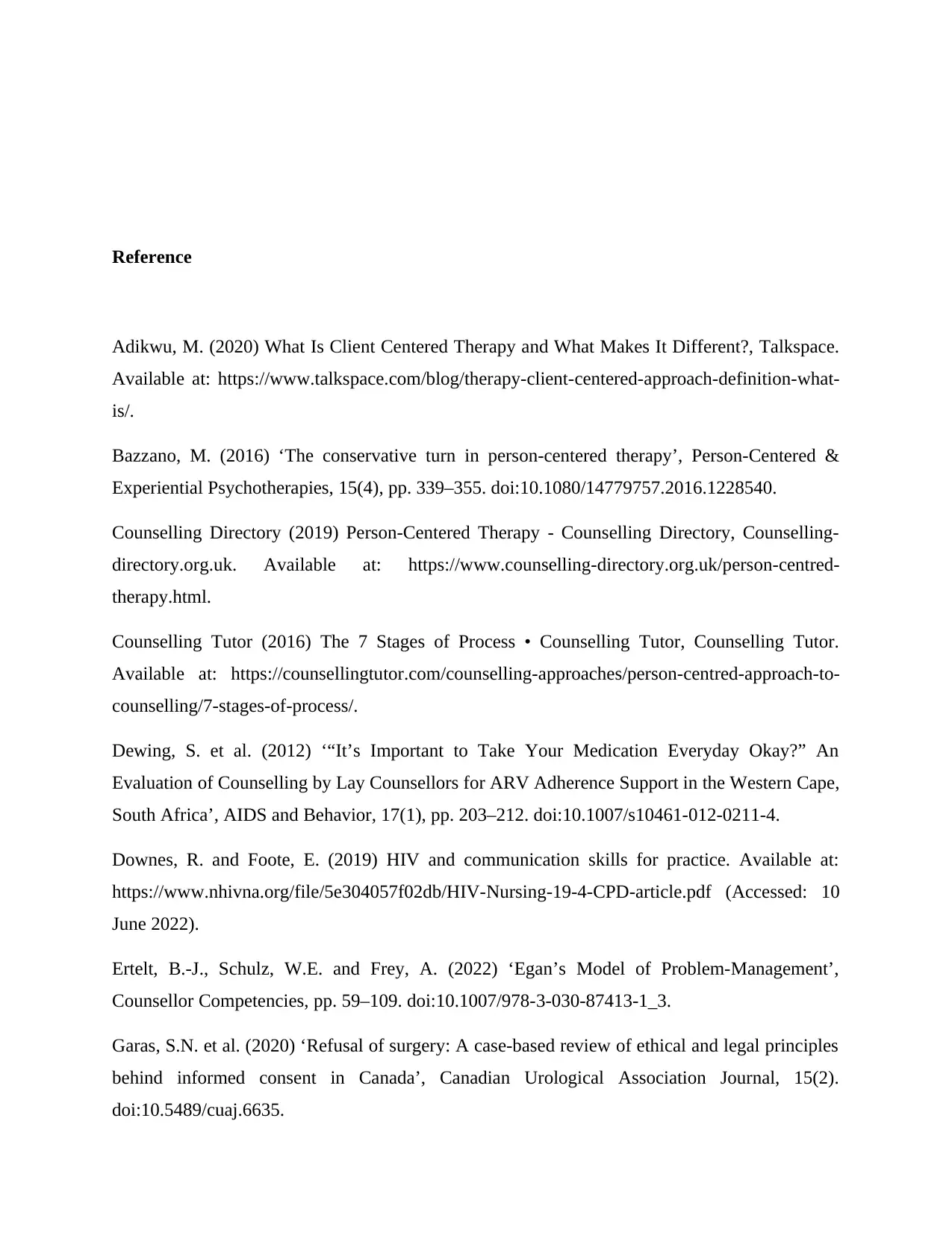
Reference
Adikwu, M. (2020) What Is Client Centered Therapy and What Makes It Different?, Talkspace.
Available at: https://www.talkspace.com/blog/therapy-client-centered-approach-definition-what-
is/.
Bazzano, M. (2016) ‘The conservative turn in person-centered therapy’, Person-Centered &
Experiential Psychotherapies, 15(4), pp. 339–355. doi:10.1080/14779757.2016.1228540.
Counselling Directory (2019) Person-Centered Therapy - Counselling Directory, Counselling-
directory.org.uk. Available at: https://www.counselling-directory.org.uk/person-centred-
therapy.html.
Counselling Tutor (2016) The 7 Stages of Process • Counselling Tutor, Counselling Tutor.
Available at: https://counsellingtutor.com/counselling-approaches/person-centred-approach-to-
counselling/7-stages-of-process/.
Dewing, S. et al. (2012) ‘“It’s Important to Take Your Medication Everyday Okay?” An
Evaluation of Counselling by Lay Counsellors for ARV Adherence Support in the Western Cape,
South Africa’, AIDS and Behavior, 17(1), pp. 203–212. doi:10.1007/s10461-012-0211-4.
Downes, R. and Foote, E. (2019) HIV and communication skills for practice. Available at:
https://www.nhivna.org/file/5e304057f02db/HIV-Nursing-19-4-CPD-article.pdf (Accessed: 10
June 2022).
Ertelt, B.-J., Schulz, W.E. and Frey, A. (2022) ‘Egan’s Model of Problem-Management’,
Counsellor Competencies, pp. 59–109. doi:10.1007/978-3-030-87413-1_3.
Garas, S.N. et al. (2020) ‘Refusal of surgery: A case-based review of ethical and legal principles
behind informed consent in Canada’, Canadian Urological Association Journal, 15(2).
doi:10.5489/cuaj.6635.
Adikwu, M. (2020) What Is Client Centered Therapy and What Makes It Different?, Talkspace.
Available at: https://www.talkspace.com/blog/therapy-client-centered-approach-definition-what-
is/.
Bazzano, M. (2016) ‘The conservative turn in person-centered therapy’, Person-Centered &
Experiential Psychotherapies, 15(4), pp. 339–355. doi:10.1080/14779757.2016.1228540.
Counselling Directory (2019) Person-Centered Therapy - Counselling Directory, Counselling-
directory.org.uk. Available at: https://www.counselling-directory.org.uk/person-centred-
therapy.html.
Counselling Tutor (2016) The 7 Stages of Process • Counselling Tutor, Counselling Tutor.
Available at: https://counsellingtutor.com/counselling-approaches/person-centred-approach-to-
counselling/7-stages-of-process/.
Dewing, S. et al. (2012) ‘“It’s Important to Take Your Medication Everyday Okay?” An
Evaluation of Counselling by Lay Counsellors for ARV Adherence Support in the Western Cape,
South Africa’, AIDS and Behavior, 17(1), pp. 203–212. doi:10.1007/s10461-012-0211-4.
Downes, R. and Foote, E. (2019) HIV and communication skills for practice. Available at:
https://www.nhivna.org/file/5e304057f02db/HIV-Nursing-19-4-CPD-article.pdf (Accessed: 10
June 2022).
Ertelt, B.-J., Schulz, W.E. and Frey, A. (2022) ‘Egan’s Model of Problem-Management’,
Counsellor Competencies, pp. 59–109. doi:10.1007/978-3-030-87413-1_3.
Garas, S.N. et al. (2020) ‘Refusal of surgery: A case-based review of ethical and legal principles
behind informed consent in Canada’, Canadian Urological Association Journal, 15(2).
doi:10.5489/cuaj.6635.
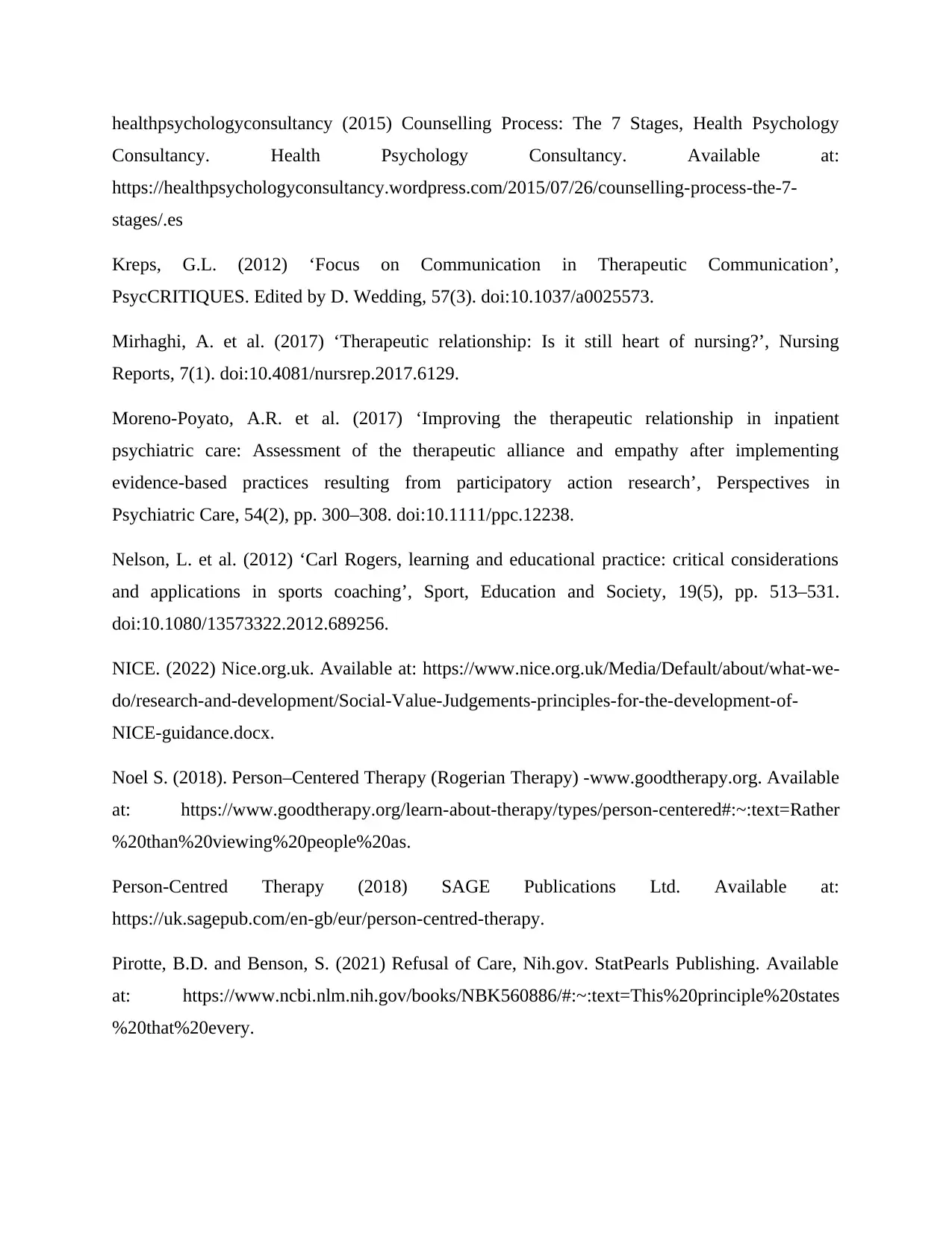
healthpsychologyconsultancy (2015) Counselling Process: The 7 Stages, Health Psychology
Consultancy. Health Psychology Consultancy. Available at:
https://healthpsychologyconsultancy.wordpress.com/2015/07/26/counselling-process-the-7-
stages/.es
Kreps, G.L. (2012) ‘Focus on Communication in Therapeutic Communication’,
PsycCRITIQUES. Edited by D. Wedding, 57(3). doi:10.1037/a0025573.
Mirhaghi, A. et al. (2017) ‘Therapeutic relationship: Is it still heart of nursing?’, Nursing
Reports, 7(1). doi:10.4081/nursrep.2017.6129.
Moreno-Poyato, A.R. et al. (2017) ‘Improving the therapeutic relationship in inpatient
psychiatric care: Assessment of the therapeutic alliance and empathy after implementing
evidence-based practices resulting from participatory action research’, Perspectives in
Psychiatric Care, 54(2), pp. 300–308. doi:10.1111/ppc.12238.
Nelson, L. et al. (2012) ‘Carl Rogers, learning and educational practice: critical considerations
and applications in sports coaching’, Sport, Education and Society, 19(5), pp. 513–531.
doi:10.1080/13573322.2012.689256.
NICE. (2022) Nice.org.uk. Available at: https://www.nice.org.uk/Media/Default/about/what-we-
do/research-and-development/Social-Value-Judgements-principles-for-the-development-of-
NICE-guidance.docx.
Noel S. (2018). Person–Centered Therapy (Rogerian Therapy) -www.goodtherapy.org. Available
at: https://www.goodtherapy.org/learn-about-therapy/types/person-centered#:~:text=Rather
%20than%20viewing%20people%20as.
Person-Centred Therapy (2018) SAGE Publications Ltd. Available at:
https://uk.sagepub.com/en-gb/eur/person-centred-therapy.
Pirotte, B.D. and Benson, S. (2021) Refusal of Care, Nih.gov. StatPearls Publishing. Available
at: https://www.ncbi.nlm.nih.gov/books/NBK560886/#:~:text=This%20principle%20states
%20that%20every.
Consultancy. Health Psychology Consultancy. Available at:
https://healthpsychologyconsultancy.wordpress.com/2015/07/26/counselling-process-the-7-
stages/.es
Kreps, G.L. (2012) ‘Focus on Communication in Therapeutic Communication’,
PsycCRITIQUES. Edited by D. Wedding, 57(3). doi:10.1037/a0025573.
Mirhaghi, A. et al. (2017) ‘Therapeutic relationship: Is it still heart of nursing?’, Nursing
Reports, 7(1). doi:10.4081/nursrep.2017.6129.
Moreno-Poyato, A.R. et al. (2017) ‘Improving the therapeutic relationship in inpatient
psychiatric care: Assessment of the therapeutic alliance and empathy after implementing
evidence-based practices resulting from participatory action research’, Perspectives in
Psychiatric Care, 54(2), pp. 300–308. doi:10.1111/ppc.12238.
Nelson, L. et al. (2012) ‘Carl Rogers, learning and educational practice: critical considerations
and applications in sports coaching’, Sport, Education and Society, 19(5), pp. 513–531.
doi:10.1080/13573322.2012.689256.
NICE. (2022) Nice.org.uk. Available at: https://www.nice.org.uk/Media/Default/about/what-we-
do/research-and-development/Social-Value-Judgements-principles-for-the-development-of-
NICE-guidance.docx.
Noel S. (2018). Person–Centered Therapy (Rogerian Therapy) -www.goodtherapy.org. Available
at: https://www.goodtherapy.org/learn-about-therapy/types/person-centered#:~:text=Rather
%20than%20viewing%20people%20as.
Person-Centred Therapy (2018) SAGE Publications Ltd. Available at:
https://uk.sagepub.com/en-gb/eur/person-centred-therapy.
Pirotte, B.D. and Benson, S. (2021) Refusal of Care, Nih.gov. StatPearls Publishing. Available
at: https://www.ncbi.nlm.nih.gov/books/NBK560886/#:~:text=This%20principle%20states
%20that%20every.
Secure Best Marks with AI Grader
Need help grading? Try our AI Grader for instant feedback on your assignments.
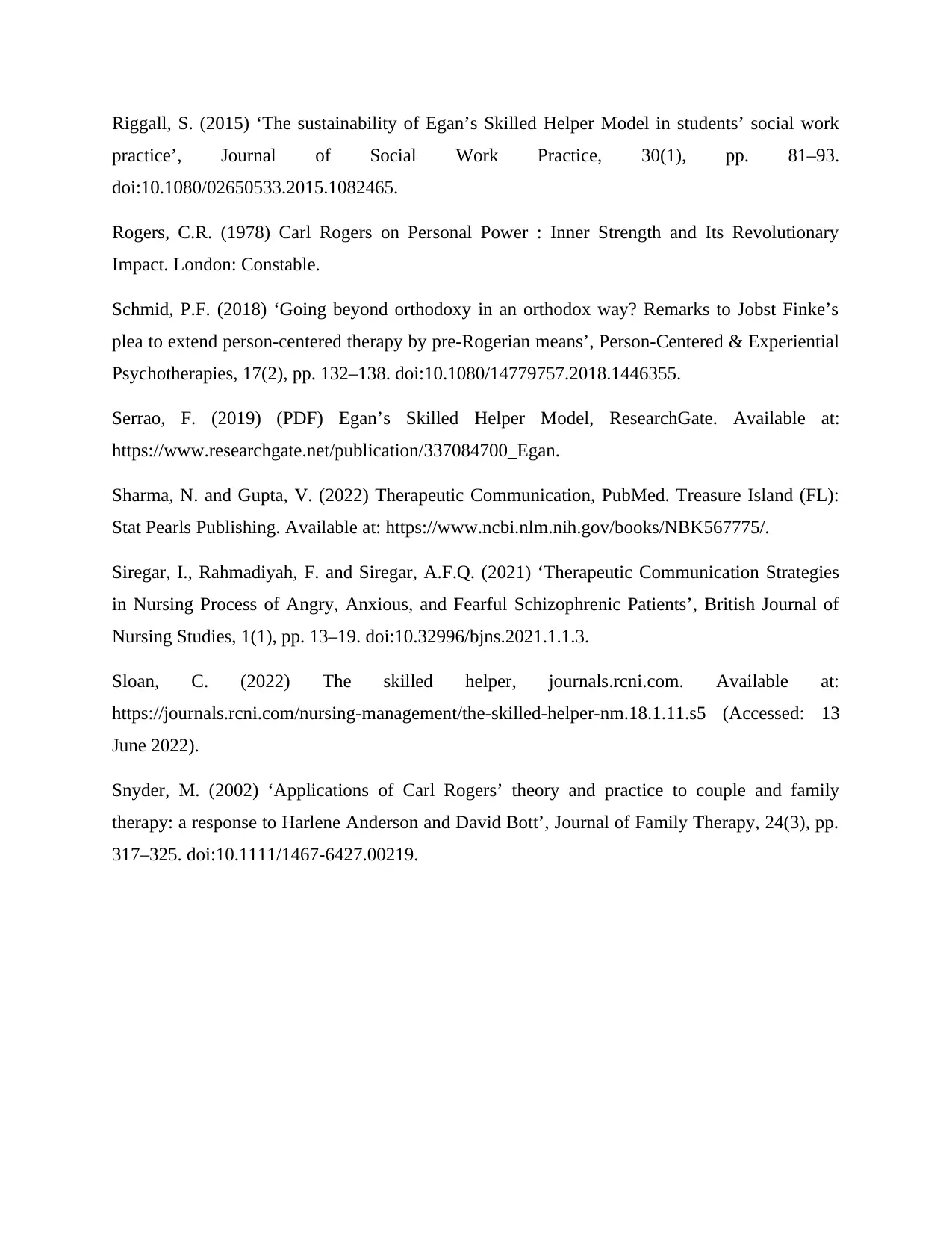
Riggall, S. (2015) ‘The sustainability of Egan’s Skilled Helper Model in students’ social work
practice’, Journal of Social Work Practice, 30(1), pp. 81–93.
doi:10.1080/02650533.2015.1082465.
Rogers, C.R. (1978) Carl Rogers on Personal Power : Inner Strength and Its Revolutionary
Impact. London: Constable.
Schmid, P.F. (2018) ‘Going beyond orthodoxy in an orthodox way? Remarks to Jobst Finke’s
plea to extend person-centered therapy by pre-Rogerian means’, Person-Centered & Experiential
Psychotherapies, 17(2), pp. 132–138. doi:10.1080/14779757.2018.1446355.
Serrao, F. (2019) (PDF) Egan’s Skilled Helper Model, ResearchGate. Available at:
https://www.researchgate.net/publication/337084700_Egan.
Sharma, N. and Gupta, V. (2022) Therapeutic Communication, PubMed. Treasure Island (FL):
Stat Pearls Publishing. Available at: https://www.ncbi.nlm.nih.gov/books/NBK567775/.
Siregar, I., Rahmadiyah, F. and Siregar, A.F.Q. (2021) ‘Therapeutic Communication Strategies
in Nursing Process of Angry, Anxious, and Fearful Schizophrenic Patients’, British Journal of
Nursing Studies, 1(1), pp. 13–19. doi:10.32996/bjns.2021.1.1.3.
Sloan, C. (2022) The skilled helper, journals.rcni.com. Available at:
https://journals.rcni.com/nursing-management/the-skilled-helper-nm.18.1.11.s5 (Accessed: 13
June 2022).
Snyder, M. (2002) ‘Applications of Carl Rogers’ theory and practice to couple and family
therapy: a response to Harlene Anderson and David Bott’, Journal of Family Therapy, 24(3), pp.
317–325. doi:10.1111/1467-6427.00219.
practice’, Journal of Social Work Practice, 30(1), pp. 81–93.
doi:10.1080/02650533.2015.1082465.
Rogers, C.R. (1978) Carl Rogers on Personal Power : Inner Strength and Its Revolutionary
Impact. London: Constable.
Schmid, P.F. (2018) ‘Going beyond orthodoxy in an orthodox way? Remarks to Jobst Finke’s
plea to extend person-centered therapy by pre-Rogerian means’, Person-Centered & Experiential
Psychotherapies, 17(2), pp. 132–138. doi:10.1080/14779757.2018.1446355.
Serrao, F. (2019) (PDF) Egan’s Skilled Helper Model, ResearchGate. Available at:
https://www.researchgate.net/publication/337084700_Egan.
Sharma, N. and Gupta, V. (2022) Therapeutic Communication, PubMed. Treasure Island (FL):
Stat Pearls Publishing. Available at: https://www.ncbi.nlm.nih.gov/books/NBK567775/.
Siregar, I., Rahmadiyah, F. and Siregar, A.F.Q. (2021) ‘Therapeutic Communication Strategies
in Nursing Process of Angry, Anxious, and Fearful Schizophrenic Patients’, British Journal of
Nursing Studies, 1(1), pp. 13–19. doi:10.32996/bjns.2021.1.1.3.
Sloan, C. (2022) The skilled helper, journals.rcni.com. Available at:
https://journals.rcni.com/nursing-management/the-skilled-helper-nm.18.1.11.s5 (Accessed: 13
June 2022).
Snyder, M. (2002) ‘Applications of Carl Rogers’ theory and practice to couple and family
therapy: a response to Harlene Anderson and David Bott’, Journal of Family Therapy, 24(3), pp.
317–325. doi:10.1111/1467-6427.00219.
1 out of 11
Related Documents
Your All-in-One AI-Powered Toolkit for Academic Success.
+13062052269
info@desklib.com
Available 24*7 on WhatsApp / Email
![[object Object]](/_next/static/media/star-bottom.7253800d.svg)
Unlock your academic potential
© 2024 | Zucol Services PVT LTD | All rights reserved.





